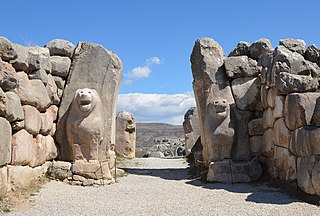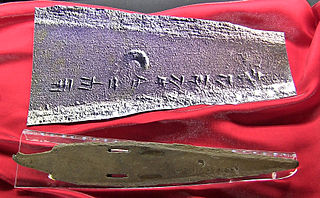
The Hittites were an Anatolian Indo-European people who formed one of the first major civilizations of Bronze Age West Asia. Possibly originating from beyond the Black Sea, they settled in modern day Turkey in the early 2nd millennium BC. The Hittites formed a series of polities in north-central Anatolia, including the kingdom of Kussara, the Kanesh or Nesha kingdom, and an empire centered on Hattusa. Known in modern times as the Hittite Empire, it reached its height during the mid-14th century BC under Šuppiluliuma I, when it encompassed most of Anatolia and parts of the northern Levant and Upper Mesopotamia.

The Hurrians were a people who inhabited the Ancient Near East during the Bronze Age. They spoke the Hurrian language, and lived throughout northern Syria, upper Mesopotamia and southeastern Anatolia.

Kültepe, also known as Kanesh or Nesha, is an archaeological site in Kayseri Province, Turkey, inhabited from the beginning of the 3rd millennium BC, in the Early Bronze Age. The nearest modern city to Kültepe is Kayseri, about 20km southwest. It consisted of an Upper city, and a lower city, where an Assyrian kārum, trading colony, was found. Its ancient names are recorded in Assyrian and Hittite sources. In cuneiform inscriptions from the 20th and the 19th century BC, the city was mentioned as Kaneš (Kanesh); in later Hittite inscriptions, the city was mentioned as Neša, or occasionally as Aniša (Anisha). In 2014, the archaeological site was inscribed in the Tentative list of World Heritage Sites in Turkey. It is the place where the earliest record of a definitively Indo-European language has been found, Hittite, dated to the 20th century BC.

The Anatolian languages are an extinct branch of Indo-European languages that were spoken in Anatolia, part of present-day Turkey. The best known Anatolian language is Hittite, which is considered the earliest-attested Indo-European language.

Luwian, sometimes known as Luvian or Luish, is an ancient language, or group of languages, within the Anatolian branch of the Indo-European language family. The ethnonym Luwian comes from Luwiya – the name of the region in which the Luwians lived. Luwiya is attested, for example, in the Hittite laws.

Cuneiform is a logo-syllabic writing system that was used to write several languages of the Ancient Near East. The script was in active use from the early Bronze Age until the beginning of the Common Era. Cuneiform scripts are marked by and named for the characteristic wedge-shaped impressions which form their signs. Cuneiform is the earliest known writing system and was originally developed to write the Sumerian language of southern Mesopotamia.

Hittite, also known as Nesite, is an extinct Indo-European language that was spoken by the Hittites, a people of Bronze Age Anatolia who created an empire centred on Hattusa, as well as parts of the northern Levant and Upper Mesopotamia. The language, now long extinct, is attested in cuneiform, in records dating from the 17th to the 13th centuries BC, with isolated Hittite loanwords and numerous personal names appearing in an Old Assyrian context from as early as the 20th century BC, making it the earliest attested use of the Indo-European languages.

Hattusa, also Hattuşa or Ḫattuša or Hattusas or Hattusha, was the capital of the Hittite Empire in the late Bronze Age during two distinct periods. Its ruins lie near modern Boğazkale, Turkey, within the great loop of the Kızılırmak River.
Hurrian is an extinct Hurro-Urartian language spoken by the Hurrians (Khurrites), a people who entered northern Mesopotamia around 2300 BC and had mostly vanished by 1000 BC. Hurrian was the language of the Mitanni kingdom in northern Mesopotamia and was likely spoken at least initially in Hurrian settlements in modern-day Syria.

In Hittite mythology, Illuyanka was a serpentine dragon slain by Tarḫunz, the Hittite incarnation of the Hurrian god of sky and storm. It is known from Hittite cuneiform tablets found at Çorum-Boğazköy, the former Hittite capital Hattusa. The contest is a ritual of the Hattian spring festival of Puruli.

Anitta, son of Pitḫana, reigned ca. 1740–1725 BC, and was a king of Kuššara, a city that has yet to be identified. He is the earliest known ruler to compose a text in the Hittite language.

Kikkuli was the Hurrian "master horse trainer [assussanni] of the land of Mitanni" and author of a chariot horse training text written primarily in the Hittite language, dating to the Hittite New Kingdom. The text is notable both for the information it provides about the development of Hittite, an Indo-European language, Hurrian, and for its content. The text was inscribed on cuneiform tablets discovered during excavations of Boğazkale and Ḫattuša in 1906 and 1907.

The Museum of Anatolian Civilizations is located on the south side of Ankara Castle in the Atpazarı area in Ankara, Turkey. It consists of the old Ottoman Mahmut Paşa bazaar storage building, and the Kurşunlu Han. Because of Atatürk's desire to establish a Hittite museum, the buildings were bought upon the suggestion of Hamit Zübeyir Koşay, who was then Culture Minister, to the National Education Minister, Saffet Arıkan. After the remodelling and repairs were completed (1938–1968), the building was opened to the public as the Ankara Archaeological Museum.
The Kaska were a loosely affiliated Bronze Age non-Indo-European tribal people, who spoke the unclassified Kaskian language and lived in mountainous East Pontic Anatolia, known from Hittite sources. They lived in the mountainous region between the core Hittite region in eastern Anatolia and the Black Sea, and are cited as the reason that the later Hittite Empire never extended northward to that area. They are sometimes identified with the Caucones known from Greek records.

Sapinuwa was a Bronze Age Hittite city at the location of modern Ortaköy in the province Çorum in Turkey about 70 kilometers east of the Hittite capital of Hattusa. It was one of the major Hittite religious and administrative centres, a military base and an occasional residence of several Hittite kings. The palace at Sapinuwa is discussed in several texts from Hattusa.

Šamuḫa is an ancient settlement near the village of Kayalı Pinar, c. 40 km west of Sivas, in the Sivas Province of Turkey. Located on the northern bank of Kizil Irmak river, it was a city of the Hittites, a religious centre and, for a few years, a military capital for the empire. Samuha's faith was syncretistic. Rene Lebrun in 1976 called Samuha the "religious foyer of the Hittite Empire".

The Hurrian songs are a collection of music inscribed in cuneiform on clay tablets excavated from the ancient Amorite-Canaanite city of Ugarit, a headland in northern Syria, which date to approximately 1400 BC. One of these tablets, which is nearly complete, contains the Hurrian Hymn to Nikkal, making it the oldest surviving substantially complete work of notated music in the world. While the composers' names of some of the fragmentary pieces are known, h.6 is an anonymous work.
Kešši or Kešše is the eponymous protagonist of a narrative of Hurrian origin known from Hattusa and Amarna. Fragments of versions in Hurrian, Hittite and Akkadian have been discovered. Individual events vary between them, and they do not fully correspond to each other, but it is agreed that they record variants of the same main narrative. In addition to Kešši himself it involved his wife Šintalimeni, his mother, his wife's evil brother Udipšarri, a number of Hurrian deities such as Kušuḫ and Kumarbi and other characters. The Hurrian version preserves sections focused on Kešši's despair after he is asked to donate his emmer, an argument between him and his wife and a number of references to events involving deities. The Hittite passages describe how Kešši abandoned his duties towards the gods and his mother after getting married, a hunting trip and a number of dreams he has in its aftermath. Individual elements of the narrative have been compared to tales focused on other heroes, namely Gurparanzaḫ and Gilgamesh.
The Kalašma language, or Kalasmaic, is an extinct Anatolian language spoken in the late Bronze Age polity of Kalašma, which lay on the northwest fringe of the Hittite Empire, likely in or around what is now the Turkish province of Bolu. The Julius-Maximilians-Universität Würzburg announced the discovery of Kalasmaic in 2023, based on a clay tablet from the Bogazköy Archive excavated at Hattusa, the Hittite capital. The tablet, written in Hittite cuneiform, is one of many in the archive recording rituals of the empire's subject and neighbouring peoples. Its Hittite-language introduction describes its main text as in "the language of the land of Kalašma". At the time its discovery was announced, the text itself had not been deciphered. Categorization of Kalasmaic within Anatolian is unclear; it is possibly a member of the Luwic branch. The text will be published once initial analysis is complete, expected in 2024.















